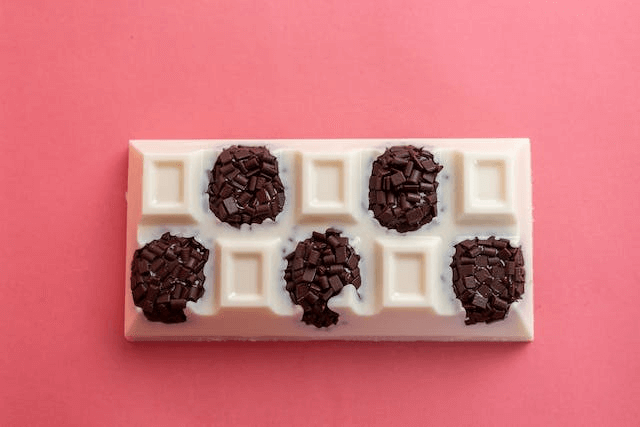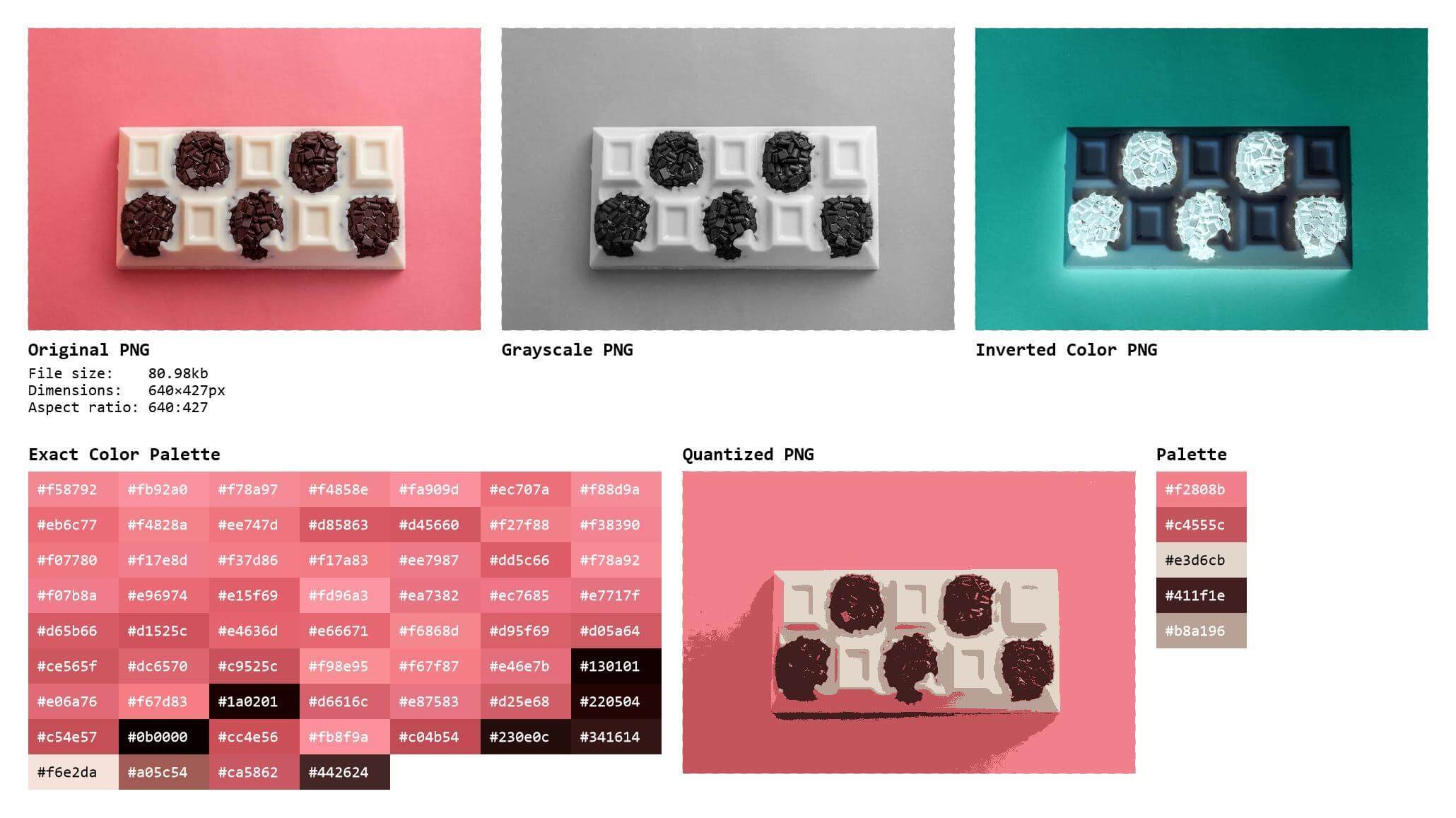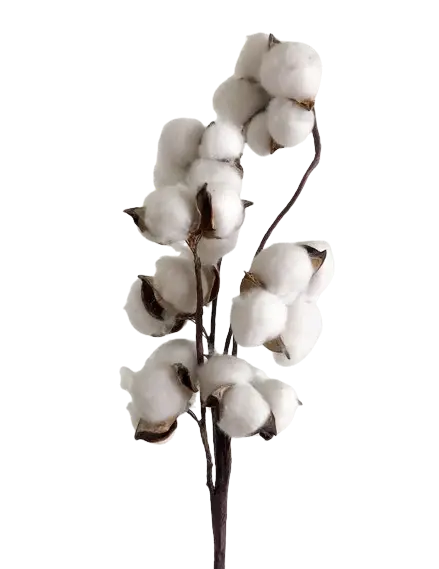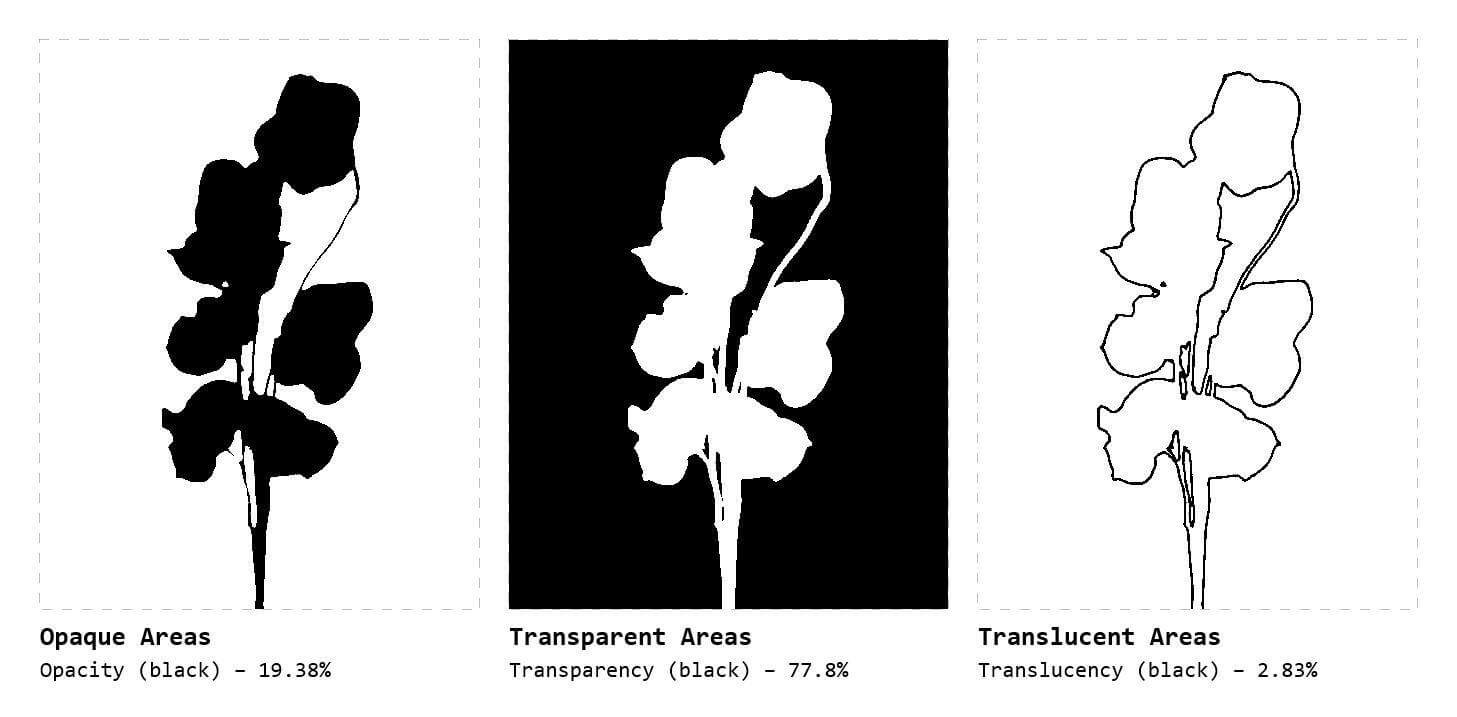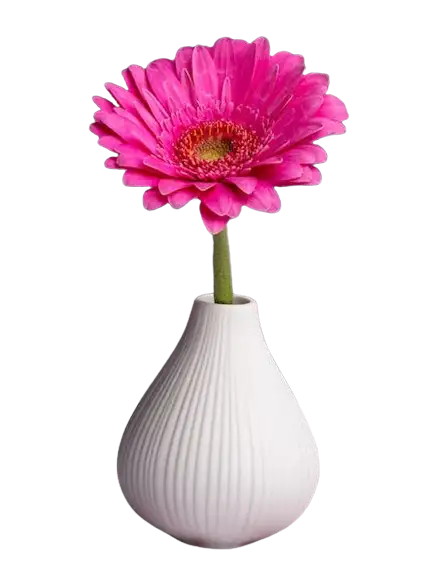World's simplest online Portable Network Graphics (PNG) viewer. Just import your PNG image in the editor on the left, and you'll see its live preview on the right. You can select properties that you want to see, such as the alpha channel information, color palette, and grayscale pixels, in the options. Free, quick, and very powerful. Created with love by team Browserling.
World's simplest online Portable Network Graphics (PNG) viewer. Just import your PNG image in the editor on the left, and you'll see its live preview on the right. You can select properties that you want to see, such as the alpha channel information, color palette, and grayscale pixels, in the options. Free, quick, and very powerful. Created with love by team Browserling.

This browser-based tool displays the given PNG on the screen and provides useful information about its components. The program can break a PNG into 8 different visual components, demonstrating various masks and colors of a PNG. The first PNG visualization can be selected via the "Preview Original PNG" checkbox in the options and it displays the original PNG in its actual size. This visualization also lets you find out the PNG size (in bytes, kilobytes, or megabytes), its dimensions (width and height), and the aspect ratio (proportion between width and height). If you find that you need to reduce the PNG file size or dimensions, you can use the PNG Optimizer or PNG Resizer tools. The next checkbox "Preview PNG in Grayscale" enables grayscale PNG visualization. To create a grayscale PNG with finely tuned weights for individual RGB color channels, you can use the Convert PNG to Grayscale utility. The next checkbox "Preview Inverted PNG" demonstrates how the original PNG looks like if its colors are inverted (when a color is inverted, the pixels get the opposite color from the color palette). Additionally, you can create a stand-alone inverted PNG using the Invert PNG Colors tool. The next three options visualize the opacity, transparency, and semi-transparency properties of a PNG. Each of these properties can be used as a mask in Photoshop or other graphics editors, and they consist of two colors – white and black. The opacity mask displays opaque areas of a PNG using a black color, while all other regions are represented in white. This mask also indicates the percentage of opaque pixels in the PNG. If you have a transparent PNG and need to make it fully opaque, you can use our Add PNG Background tool, which fills the transparent areas with any color. The next mask, the transparency mask, does the opposite – it highlights fully transparent areas in the PNG using a black color and opaque areas in a white color. This mask helps determine the percentage of transparent areas in a PNG. If you have a non-transparent PNG and you need to make some areas transparent, you can use our Remove a Color from a PNG program. The next mask, the semi-transparency mask, visualizes translucent regions in a PNG with a black color (the translucent regions have an alpha channel greater than 0 but less than 1). With this mask, you can also calculate the percentage of semi-transparent pixels in the original PNG. To adjust the semi-transparent edges of PNG objects, you can use the Refine PNG Edges tool that we created. The last two options display two different color palettes of a PNG. The first checkbox "Show Exact Colors" generates a color palette with the exact colors in a PNG. This color table includes all shades that are used in a PNG from the most to least frequently used. The number of colors that should be displayed in the exact color table can be specified in the option below the checkbox. If you need a complete palette of exact colors with color codes that you can copy as text, you can use our Extract PNG Color Palette tool. The second checkbox "Show Quantized Colors" creates a quantized PNG and finds its palette. Image quantization redraws the original PNG using a limited color palette. Such an image provides a simplified representation of the original PNG and identifies its dominant shades. The number of shades for the quantized PNG can also be specified in the options. Additionally, to create a stand-alone quantized PNG, you can use our Quantize PNG program. Png-abulous!
This browser-based tool displays the given PNG on the screen and provides useful information about its components. The program can break a PNG into 8 different visual components, demonstrating various masks and colors of a PNG. The first PNG visualization can be selected via the "Preview Original PNG" checkbox in the options and it displays the original PNG in its actual size. This visualization also lets you find out the PNG size (in bytes, kilobytes, or megabytes), its dimensions (width and height), and the aspect ratio (proportion between width and height). If you find that you need to reduce the PNG file size or dimensions, you can use the PNG Optimizer or PNG Resizer tools. The next checkbox "Preview PNG in Grayscale" enables grayscale PNG visualization. To create a grayscale PNG with finely tuned weights for individual RGB color channels, you can use the Convert PNG to Grayscale utility. The next checkbox "Preview Inverted PNG" demonstrates how the original PNG looks like if its colors are inverted (when a color is inverted, the pixels get the opposite color from the color palette). Additionally, you can create a stand-alone inverted PNG using the Invert PNG Colors tool. The next three options visualize the opacity, transparency, and semi-transparency properties of a PNG. Each of these properties can be used as a mask in Photoshop or other graphics editors, and they consist of two colors – white and black. The opacity mask displays opaque areas of a PNG using a black color, while all other regions are represented in white. This mask also indicates the percentage of opaque pixels in the PNG. If you have a transparent PNG and need to make it fully opaque, you can use our Add PNG Background tool, which fills the transparent areas with any color. The next mask, the transparency mask, does the opposite – it highlights fully transparent areas in the PNG using a black color and opaque areas in a white color. This mask helps determine the percentage of transparent areas in a PNG. If you have a non-transparent PNG and you need to make some areas transparent, you can use our Remove a Color from a PNG program. The next mask, the semi-transparency mask, visualizes translucent regions in a PNG with a black color (the translucent regions have an alpha channel greater than 0 but less than 1). With this mask, you can also calculate the percentage of semi-transparent pixels in the original PNG. To adjust the semi-transparent edges of PNG objects, you can use the Refine PNG Edges tool that we created. The last two options display two different color palettes of a PNG. The first checkbox "Show Exact Colors" generates a color palette with the exact colors in a PNG. This color table includes all shades that are used in a PNG from the most to least frequently used. The number of colors that should be displayed in the exact color table can be specified in the option below the checkbox. If you need a complete palette of exact colors with color codes that you can copy as text, you can use our Extract PNG Color Palette tool. The second checkbox "Show Quantized Colors" creates a quantized PNG and finds its palette. Image quantization redraws the original PNG using a limited color palette. Such an image provides a simplified representation of the original PNG and identifies its dominant shades. The number of shades for the quantized PNG can also be specified in the options. Additionally, to create a stand-alone quantized PNG, you can use our Quantize PNG program. Png-abulous!
In this example, we load a PNG of a chocolate bar and view it through five filters. The first filter is the original PNG in its actual size and dimensions. This filter does nothing but it's useful for comparing the original PNG with all other filters. The second filter is the PNG in grayscale colors. The third filter is the PNG in inverted colors. The fourth and fifth filters are the color palette filters. They display the 60 most popular exact colors found in the PNG and generate a quantized PNG from a 5-color palette. (Source: Pexels.)
In this example, we explore the transparency properties of a PNG of a blooming white cotton. To do this, we activate three checkboxes from the second block of options and generate an opacity mask, a transparency mark, and a semi-transparency mask. The first mask displays opaque areas in black, which make up 19.38% of the PNG. The second mask shows transparent regions in black, which make up 77.8% of the PNG. The third mask visualizes semi-transparent areas in black, which make up 2.83% of the PNG. (Source: Pexels.)
In this example, we conduct a comprehensive review of a PNG image by generating all filters and masks. The first row of properties displays the original PNG, grayscale PNG, and color-inverted PNG. The second row of information shows the opacity, transparency, and semi-transparency masks. The third row displays the top 50 colors from the exact palette and quantized PNG with an 8-shade palette. (Source: Pexels.)
Edit a PNG in your browser.
Compare two or more PNG images.
Convert a PNG image to an AV1 image (AVIF).
Convert an AV1 image (AVIF) to a PNG image.
Convert a PNG image to a High Efficiency Image File (HEIF).
Convert a Hide Efficiency Image File (HEIF) to a PNG image.
Convert a PNG image to an ICO icon.
Convert a PNG image to a TIFF image.
Convert a TIFF image to a PNG image.
Convert a PNG image to a PIK image.
Convert a PIK image to a PNG image.
Convert a PNG image to a PPM image.
Convert a PPM image to a PNG image.
Convert a PNG image to a BPG image.
Convert a BPG image to a PNG image.
Convert a PNG image to a FLIF image.
Convert a FLIF image to a PNG image.
Convert a PNG image to a Paint.net file.
Convert a Paint.net file to a PNG image.
Convert a PNG image to a Photoshop file.
Convert a Photoshop file to a PNG image.
Convert a PNG image to an SVG image.
Convert a PNG image to an PDF document.
Convert a PDF document to a PNG image (or multiple images).
Convert a PNG image to an EPS file.
Convert an EPS file to a PNG image (or multiple images).
Convert a PNG image to a JFIF image.
Convert a JFIF image to a PNG image.
Convert a PNG image to raw RGB values.
Convert RGB values to a PNG image.
Convert a PNG image to raw BGR values.
Convert BGR values to a PNG image.
Convert a PNG image to raw RGBA values.
Convert RGBA values to a PNG image.
Convert a PNG image to raw BGRA values.
Convert BGRA values to a PNG image.
Convert multiple PNGs to a GIF animation.
Convert an APNG animation to a GIF image.
Convert a GIF animation to an APNG image.
Convert an APNG image to a Webp image.
Convert a Webp image to an APNG image.
Convert an APNG image to an MP4 video.
Convert an MP4 video to an APNG image.
Convert an APNG image to an AVI video.
Convert an AVI video to an APNG image.
Convert an APNG image to a WMV video.
Convert an WMV video to an APNG image.
Extract all frames from an APNG image.
Play a PNG animation (APNG) frame by frame.
Change the playback speed of an animated PNG (APNG).
Change how many times an animated PNG loops.
Reverse the order of frames in an animated PNG (APNG).
Created animated PNGs (APNGs) from input images.
Check if the given PNG file is an animated PNG file (APNG).
Create a sprite sheet from all animated PNG (APNG) frames.
Create an animated PNG (APNG) from a sprite sheet.
Create Excel art from a PNG image.
Randomly distort data in a PNG file to make a glitched PNG.
Find all grayscale pixels in a PNG (grayscale mask).
Find all color pixels in a PNG (color mask).
Invert the alpha channel values in a PNG.
Break a PNG image into multiple pieces.
Generate a slideshow animation from multiple PNGs.
Generate a mosaic wall from multiple PNGs.
Convert a PNG into a hexagonal grid of pixels.
Convert a PNG into a triangular grid of pixels.
Create a Voronoi diagram from a PNG image.
Darken PNG corners compared to its center.
Create multiple reflections of a PNG.
Apply a Bayer filter on a PNG.
Make a PNG look like it was taken via night vision goggles.
Make a PNG look like it's spherical.
Run a PNG through the Mobius Transform.
Convert between RGB, CMYK, HSV, and HSL color spaces.
Convert between 8-bit, 16-bit, 24-bit, and 32-bit PNG depths.
Remove dithering from a PNG image.
Convert a PNG to an ASCII art image.
Convert ASCII art to a PNG image.
Convert a PNG to an ANSI art image.
Convert ANSI art to a PNG image.
Convert a PNG to a Braille art image.
Convert Braille art to a PNG image.
Create a PNG image from the given bytes.
Convert a PNG image to bytes.
Increase the quality of a PNG image.
Extract a 2d slice from a PNG.
Create a PNG that contains all possible RGB colors.
Find all textual information in a PNG image and extract it.
Given any 2D PNG, add 3rd dimension to it.
Quickly erase text (labels, captions) from a PNG.
Quickly delete a watermark from a PNG.
Salvage a PNG that has bad bytes in it and doesn't open.
Conceal a secret message in a PNG image.
Update meta data of a PNG file.
Delete meta data from a PNG picture.
Check if the given file is a valid PNG without errors.
Subscribe to our updates. We'll let you know when we release new tools, features, and organize online workshops.
Enter your email here
We're Browserling — a friendly and fun cross-browser testing company powered by alien technology. At Browserling we love to make people's lives easier, so we created this collection of online PNG tools. We created the simplest possible user interface for our tools and they are now used by millions of users every month. Behind the scenes, our online PNG tools are actually powered by our web developer tools that we created over the last couple of years. Check them out!
